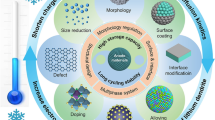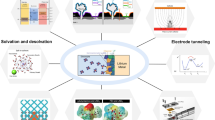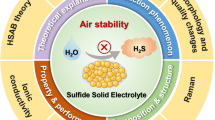Abstract
Thermodynamic simulations are performed in all areas of materials processing because of the advances that have taken place in computer software for complex non-ideal calculations, together with the increasing availability of evaluated data for different phases. In the present work, a thermodynamic model of electrolytic solutions was applied to determine the reaction conditions favoring the hydrothermal synthesis of the following electroceramics: zinc ferrites, sodium niobates, and lead zirconates. Stability and yield diagrams were constructed relating the equilibrium concentration of all of the aqueous and solid species as functions of temperature, pressure, pH, and input reagent concentrations. The theoretical predictions avoided the empirical trial-and-error method of synthesis and were corroborated by experiments. The results demonstrate the important role that such thermodynamic simulations can play in significantly reducing the time and costs associated with hydrothermal processing.
Similar content being viewed by others
References
Férey, G., Jacobson, A.J.: Synthesis and reactivity of solids from “mild” to “severe” chemistry for “smart” materials. Curr. Op. Sol. State Mater. Sci. 4, 109–111 (1999)
Gopalakrishnan, J.: Chimie douce approaches to the synthesis of metastable oxide ceramics. Chem. Mater. 7, 1265–1275 (1995)
Matsumoto, Y.: Soft solution processing for high performance inorganic materials—Introduction. J. Mater. Res. 13, 795 (1998)
Yu, S.H.: Hydrothermal/solvothermal processing of advanced ceramic materials. J. Ceram. Soc. Japan 109, S65–S75 (2001)
Dias, A., Matinaga, F.M., Moreira, R.L.: Raman spectroscopy of (Ba1- x Sr x )(Mg1/3Nb2/3)O −3 solid solutions from microwave-hydrothermal powders. Chem. Mater. 19, 2335–2341 (2007)
Riman, R.E., Suchanek, W.L., Lencka, M.M.: Hydrothermal crystallization of ceramics. Ann. Chim.-Sci. Mater. 27, 15–36 (2002)
Anderko, A., Sanders, S.J., Young, R.D.: Real-solution stability diagrams: a thermodynamic tool for modeling corrosion in wide temperature and concentration ranges. Corrosion 53, 43–53 (1997)
Zemaitis, J.F. Jr., Clarck, D.M., Rafal, M., Scrivner, N.C.: Handbook of Aqueous Electrolyte Thermodynamics: Theory and Applications. DIPPR/AIChE, New York (1986)
Rafal, M., Berthold, J.W., Scrivner, N.C.: Models for electrolyte solutions. In: Sandler, S.I. (ed.) Models for Thermodynamic and Phase Equilibria Calculations. Marcel Dekker, New York (1995)
Oelkers, E.H., Helgeson, H.C.: Multiple ion association in supercritical aqueous-solutions of single electrolytes. Science 261, 888–891 (1993)
Harvie, C.E., Moller, N., Weare, J.H.: The prediction of mineral solubilities in natural-waters—the Na–K–Mg–Ca–H–Cl–SO4–OH–HCO3–CO3–CO2–H2O system to high ionic strengths at 25 degrees C. Geochim. Cosmochim. Acta 48, 723–751 (1984)
Gurvich, L.V., Veyts, I.V., Alcock, C.B.: Thermodynamic Properties of Individual Substances, 4th edn., vol. 1–2. Hemisphere Publishing Corporation, New York (1989/1990)
Shock, E.L., Helgeson, H.C.: Calculation of the thermodynamic and transport properties of aqueous species at high pressures and temperatures: correlation algorithms for ionic species and equation of state predictions to 5 kb and 1000 °C. Geochim. Cosmochim. Acta 52, 2009–2036 (1988)
Sverjensky, D.A.: Calculations of the thermodynamic properties of aqueous species and the solubilities of minerals in supercritical electrolyte solutions. In: Carmichael, I.S.E., Eugster, H.P. (eds.) Reviews in Mineralogy. Thermodynamic Modeling of Geologic Materials: Minerals, Fluids and Melts, vol. 17, pp. 177–209. Mineralogical Society of America, Chelsea (1987)
Dauber, T.E., Danner, R.P.: Physical and Thermodynamic Properties of Pure Chemicals. Data Compilation, DIPPR Database 801, Parts 1–4. Hemisphere Publishing Corporation, New York (1989) (Jan. 1990 Release)
Barin, I.: Thermochemical Data of Pure Substances, Parts I and II. VCH, Weinheim (1989)
Ciminelli, V.S.T., Dias, A.: Theoretical predictions and experimental results of the hydrothermal processing of strontium tungstates. Ferroelectrics 241, 1915–1922 (2000)
Dias, A., Ciminelli, V.S.T.: Thermodynamic calculations and modeling of the hydrothermal synthesis of nickel tungstates. J. Eur. Ceram. Soc. 21, 2061–2065 (2001)
Dias, A., Buono, V.T.L.: Hydrothermal synthesis and sintering of nickel and manganese-zinc ferrites. J. Mater. Res. 12, 3278–3285 (1997)
Dias, A., Mohallem, N.D.S., Moreira, R.L.: Solid-state sintering of hydrothermal powders: Densification and grain growth kinetics of nickel–zinc ferrites. Mater. Res. Bull. 33, 475–486 (1998)
Dias, A., Mohallem, N.D.S., Moreira, R.L.: Dielectric properties of hydrothermal nickel–zinc ferrites. J. Physique III 6, 843–852 (1996)
Teixeira, N.G., Dias, A., Moreira, R.L.: Raman scattering study of the high temperature phase transitions of NaTaO3. J. Eur. Ceram. Soc. 27, 3683–3686 (2007)
Randolph, A.D., Larson, M.A.: Theory of Particulate Processes: Analysis and Techniques of Continuous Crystallization. Academic Press, San Diego (1988)
Lencka, M.M., Riman, R.E.: Synthesis of lead titanate—Thermodynamic modeling and experimental verification. J. Am. Ceram. Soc. 76, 2649–2659 (1993)
Gersten, B., Lencka, M.M., Riman, R.E.: Engineered low temperature hydrothermal synthesis of phase-pure lead-based perovskites using ethylenediamine tetra-acetic acid complexation. Chem. Mater. 14, 1950–1960 (2002)
Cho, S.B., Noh, J.S., Lencka, M.M., Riman, R.E.: Low temperature hydrothermal synthesis and formation mechanisms of lead titanate (PbTiO3) particles using tetramethylammonium hydroxide: thermodynamic modelling and experimental verification. J. Eur. Ceram. Soc. 23, 2323–2335 (2003)
Pauley, J.L., Testerman, M.K.: Basic salts of lead nitrate formed under aqueous media. J. Am. Chem. Soc. 76, 4220–4222 (1954)
Author information
Authors and Affiliations
Corresponding author
Rights and permissions
About this article
Cite this article
Dias, A. Thermodynamic Studies as Predictive Tools of the Behavior of Electroceramics Under Different Hydrothermal Environments. J Solution Chem 38, 843–856 (2009). https://doi.org/10.1007/s10953-009-9413-4
Received:
Accepted:
Published:
Issue Date:
DOI: https://doi.org/10.1007/s10953-009-9413-4




